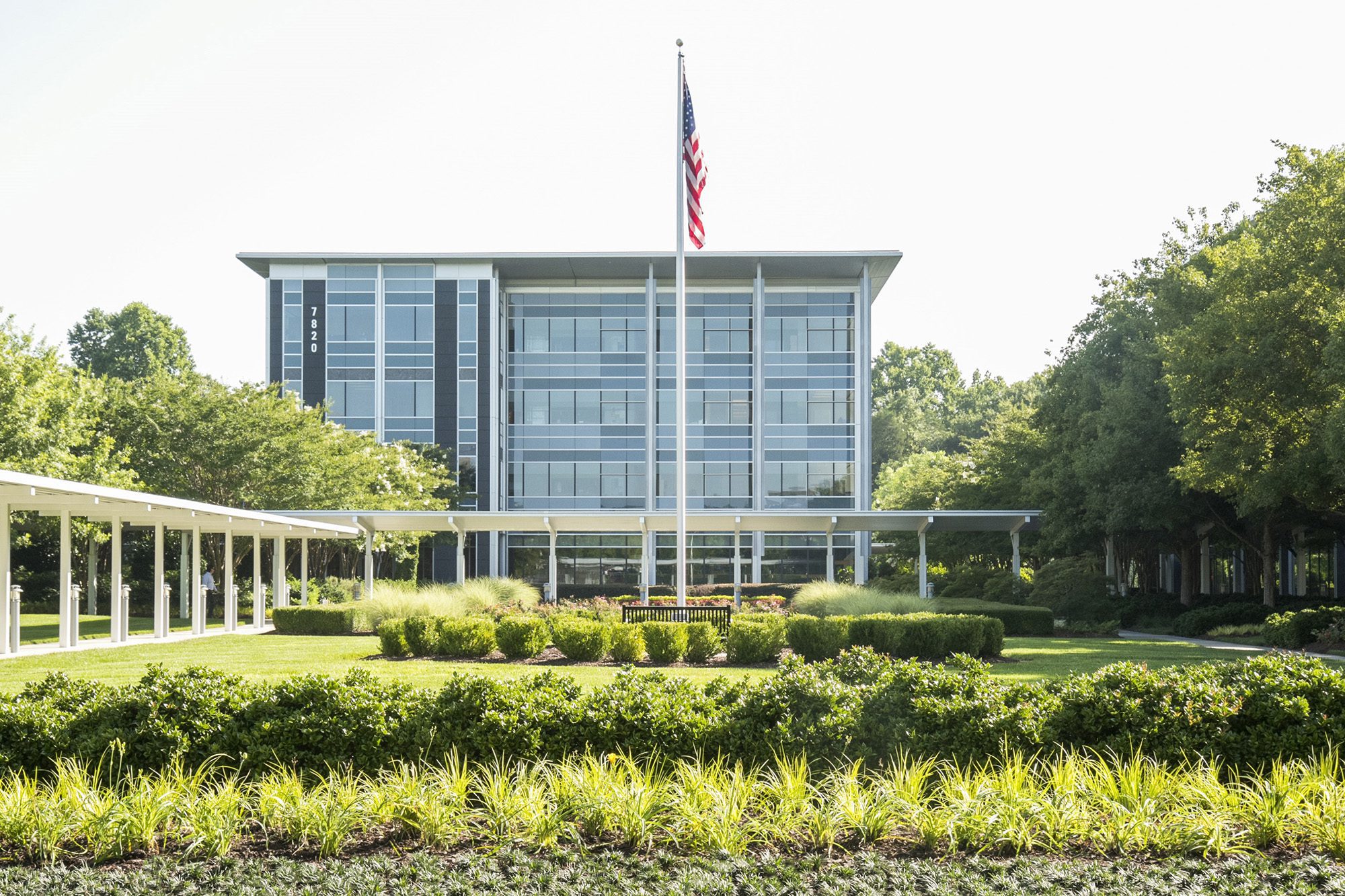
Project Name: A Corporate Communications Campus in Charlotte
Location: Charlotte, NC
Project Scope: Installation and annual maintenance, maintenance of walkways, turf, beds, trees, pots, building entrances, roadways, perennial and tree care, pruning, irrigation maintenance, snow removal.
Date Project Maintenance Began: June 2014
Ruppert Branch: Charlotte, NC Landscape Management Branch
Ruppert Team Members who Worked on the Project: Josh Lawson (branch manager), Tito Caceres (area manager), Patrick Shelley (field manager), Joaquin Portimao, Taval Alexander and Toure Bradley (crewmen).
Industry Awards Won: National Association of Landscape Professionals (NALP) 2016 Grand Award, Landscape Contractors Association (LCA) 2016 Grand Award
Site Description: This sprawling 83-acre corporate campus for a communications company features a memorial garden, reflecting pool, wildflower meadow, an abundance of outdoor seating areas and extensive walking trails for the enjoyment of over 1700 employees and numerous visitors. Located directly off I-77 in Charlotte, the campus borders a 35 acre tract of open pasture, forest and wetland. Two of the five Class A office buildings as well as the site’s secure data center are LEED certified and the main buildings are connected by covered walkways. The entire site is designed to promote interconnectivity and harmony with its natural setting.
%20Charlotte%20Corp%20Campus.jpg?AWSAccessKeyId=AKIAJ3YBR5GY2XF7YLGQ&Expires=1564317876&response-content-disposition=inline%3B%20filename%3D%28002%29%20Charlotte%20Corp%20Campus.jpg&response-content-type=image%2Fjpeg&Signature=zYVGECqjMqCFYBFmhPbjrGOWmZc%3D)
The five office buildings are connected by a series of covered walkways to promote a feeling on interconnectivity on this sprawling 83-acre campus.
The site is over a dozen years old and has grown in phases. When plant material is displaced due to construction, the client prefers to reuse it in other areas, often requiring temporary holding areas that are also maintained. One Japanese maple, such as those pictured here by the reflecting pool, has been transplanted three times and now resides in the memorial garden.
%20Charlotte%20Corp%20Campus.jpg?AWSAccessKeyId=AKIAJ3YBR5GY2XF7YLGQ&Expires=1564317876&response-content-disposition=inline%3B%20filename%3D%28004%29%20Charlotte%20Corp%20Campus.jpg&response-content-type=image%2Fjpeg&Signature=7qbS7dBvppRb2PCMrsFsXs3RnhE%3D)
Boulders unearthed during various construction phases were repurposed throughout the campus to add visual points of interest. With boulders and bedrock as the site’s predominant foundation, landscape crews must add healthier soil and organic matter to the beds and turf more frequently to enable plant growth.
%20Charlotte%20Corp%20Campus.jpg?AWSAccessKeyId=AKIAJ3YBR5GY2XF7YLGQ&Expires=1564317876&response-content-disposition=inline%3B%20filename%3D%28005%29%20Charlotte%20Corp%20Campus.jpg&response-content-type=image%2Fjpeg&Signature=7RUxGqJUpLjh96X05Ouj%2F6S1cnI%3D)
There are 1.5 acres of fire lanes to enable emergency vehicle access. While meant to blend with the rest of the turf, they require a layer of gravel and sand pavers below the turf to bear the vehicle weight. This paver material heats easily, which requires the contractor to closely monitor irrigation, overseed and topdress to ensure turf viability.
As it’s evolved, campus enhancements have been used to provide visual interest, correct for challenges and add material that meets LEED requirements, requiring less maintenance. Eighty percent of these high-visibility beds are located in the shade, so the contractor has worked closely with the client to provide a shade resistant plant palate.
%20Charlotte%20Corp%20Campus.jpg?AWSAccessKeyId=AKIAJ3YBR5GY2XF7YLGQ&Expires=1564317876&response-content-disposition=inline%3B%20filename%3D%28007%29%20Charlotte%20Corp%20Campus.jpg&response-content-type=image%2Fjpeg&Signature=G65ZAVfSKPh5sMIu3Cq%2BKZzBHrs%3D)
In addition to regular enhancements, the contractor’s scope has evolved to include installation and maintenance of additional landscape areas, including (114) 6 ft. holly trees surrounding a new 1.5 acre solar field. The contractor also maintains the wild grass beneath the solar panels, applying growth regulator to minimize maintenance and keep machines away from the panels as much as possible.
A wildflower meadow was installed to create visual interest while requiring very low maintenance. It has become a naturalized area, seeding itself and only requiring the contractor to mow once a year.
In addition to the contractor’s weekly maintenance visit, a dedicated crewperson is stationed onsite five days a week, eight hours a day and is responsible for keeping all 20 flower beds (totaling 1,700 sq/ft) trim and tight and keeping over two miles of walking trails clean and level.
%20Charlotte%20Corp%20Campus.jpg?AWSAccessKeyId=AKIAJ3YBR5GY2XF7YLGQ&Expires=1564317876&response-content-disposition=inline%3B%20filename%3D%28010%29%20Charlotte%20Corp%20Campus.jpg&response-content-type=image%2Fjpeg&Signature=BQnQ339mIHWRk38GsDKn9x1WoPY%3D)
The contractor is tasked with extreme responsiveness during periods of expected snowfall or icy conditions. The campus’s main roadways and parking areas must remain accessible for employees at all times.
%20Charlotte%20Corp%20Campus.jpg?AWSAccessKeyId=AKIAJ3YBR5GY2XF7YLGQ&Expires=1564317876&response-content-disposition=inline%3B%20filename%3D%28011%29%20Charlotte%20Corp%20Campus.jpg&response-content-type=image%2Fjpeg&Signature=5h4XZ77%2FCqiB36DB1fr%2BI0%2BKx2o%3D)
The campus is adjacent to wetlands and has a large wildlife population. The geese on the property create extra challenges for the landscape contractor which requires aerating and overseeding turf areas denuded by the geese and the dedicated crewperson spends up to an hour per day scrubbing and pressure washing the walkways around the buildings to remove excrement.
In addition to geese, the site has a large population of deer and rabbits. The contractor has chosen deer-resistant plant varieties for enhancements, including shrubs like azaleas, hollies, ogon, barberry and distylium, ferns and tall decorative grasses like mulhy grass, and perennials such as irises and astilbe.
While the majority of the site features perennials for sustainability, highly visible areas including the site entrance and roundabout feature bright, colorful annuals. These are inspected for weeds daily, treated with fungicide and fertilizer every 21 days, and rotated 2-3 times per year – in the fall, spring and/or early summer.
Expectations are high on this site and the client is very involved with decisions regarding the landscape and its care. The contractor is constantly challenged to provide new looks for portions of the site that add new plant varieties, colors, textures and patterns into the mix to keep the site vibrant.
Providing a consistently high standard of maintenance in this landscape is challenging. But with strong communication between all parties and an eye to detail, the project—which is always growing in scope—seems to be accomplishing its goal of creating a top notch landscape for its employees and visitors.
%20Charlotte%20Corp%20Campus.JPG?AWSAccessKeyId=AKIAJ3YBR5GY2XF7YLGQ&Expires=1564317876&response-content-disposition=inline%3B%20filename%3D%28003%29%20Charlotte%20Corp%20Campus.JPG&response-content-type=image%2Fjpeg&Signature=xn9%2Fz0yxJhPXI1H17g2cCPrM5bM%3D)
%20Charlotte%20Corp%20Campus.JPG?AWSAccessKeyId=AKIAJ3YBR5GY2XF7YLGQ&Expires=1564317876&response-content-disposition=inline%3B%20filename%3D%28006%29%20Charlotte%20Corp%20Campus.JPG&response-content-type=image%2Fjpeg&Signature=L%2B34XtJm%2Fu8tzNOpn1nV%2BS8pyos%3D)
%20Charlotte%20Corp%20Campus.JPG?AWSAccessKeyId=AKIAJ3YBR5GY2XF7YLGQ&Expires=1564317876&response-content-disposition=inline%3B%20filename%3D%28008%29%20Charlotte%20Corp%20Campus.JPG&response-content-type=image%2Fjpeg&Signature=HmxlL5UkCPsRYHCPJOURD4W8c%2FQ%3D)
%20Charlotte%20Corp%20Campus.JPG?AWSAccessKeyId=AKIAJ3YBR5GY2XF7YLGQ&Expires=1564317876&response-content-disposition=inline%3B%20filename%3D%28009%29%20Charlotte%20Corp%20Campus.JPG&response-content-type=image%2Fjpeg&Signature=d%2BDrs5nZ2dMfJcT4sUU8tZWx7Sg%3D)
%20Charlotte%20Corp%20Campus.JPG?AWSAccessKeyId=AKIAJ3YBR5GY2XF7YLGQ&Expires=1564317876&response-content-disposition=inline%3B%20filename%3D%28012%29%20Charlotte%20Corp%20Campus.JPG&response-content-type=image%2Fjpeg&Signature=SMx88dNkqBPgEVnRrrnE7shA6Dw%3D)
%20Charlotte%20Corp%20Campus.JPG?AWSAccessKeyId=AKIAJ3YBR5GY2XF7YLGQ&Expires=1564317876&response-content-disposition=inline%3B%20filename%3D%28013%29%20Charlotte%20Corp%20Campus.JPG&response-content-type=image%2Fjpeg&Signature=Q276Ep8ru8JfMH7ioDtOLqblcH4%3D)
%20Charlotte%20Corp%20Campus.JPG?AWSAccessKeyId=AKIAJ3YBR5GY2XF7YLGQ&Expires=1564317876&response-content-disposition=inline%3B%20filename%3D%28014%29%20Charlotte%20Corp%20Campus.JPG&response-content-type=image%2Fjpeg&Signature=jqStSQzlm6Gba0a1nht4LU1CxKM%3D)
%20Charlotte%20Corp%20Campus.JPG?AWSAccessKeyId=AKIAJ3YBR5GY2XF7YLGQ&Expires=1564317876&response-content-disposition=inline%3B%20filename%3D%28015%29%20Charlotte%20Corp%20Campus.JPG&response-content-type=image%2Fjpeg&Signature=XWFQcp0qd0iKZbqJwNdLRsP22Gw%3D)